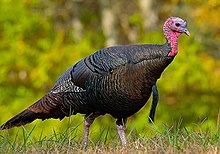Turkey (bird)
| Turkey Temporal range: 23–0 Ma Early Miocene – Recent |
|
|---|---|
 |
|
| Wild turkey | |
| Scientific classification | |
| Kingdom: | Animalia |
| Phylum: | Chordata |
| Class: | Aves |
| Order: | Galliformes |
| Family: | Phasianidae |
| Subfamily: | Meleagridinae |
| Genus: |
Meleagris Linnaeus, 1758 |
| Species | |
The turkey is a large bird in the genus Meleagris, which is native to the Americas. One species, Meleagris gallopavo (commonly known as the domestic turkey or wild turkey), is native to the forests of North America, from Mexico, throughout the midwest and eastern United States, and into southeastern Canada. The other living species is Meleagris ocellata or the ocellated turkey, native to the forests of the Yucatán Peninsula. Males of both turkey species have a distinctive fleshy wattle or protuberance that hangs from the top of the beak (called a snood). They are among the largest birds in their ranges. As in many galliformes, the male is larger and much more colorful than the female.
Turkeys are classed in the family of Phasianidae (pheasants, partridges, francolins, junglefowl, grouse and relatives) in the taxonomic order of Galliformes. The genus Meleagris is the only extant genus in the subfamily Meleagridinae, formerly known as the family Meleagrididae, but now subsumed within the family Phasianidae.
There are two theories for the derivation of the name "turkey" for this bird, according to Columbia University professor of Romance languages Mario Pei. One theory is that when Europeans first encountered turkeys in America, they incorrectly identified the birds as a type of guineafowl, which were already being imported into Europe by Turkey merchants via Constantinople and were therefore nicknamed Turkey coqs. The name of the North American bird thus became "turkey fowl" or "Indian turkeys", which was then shortened to just "turkeys".
...
Wikipedia
